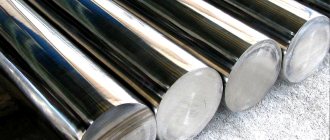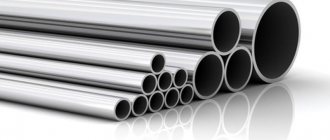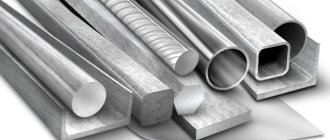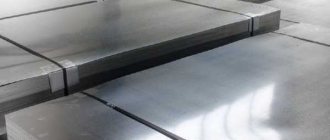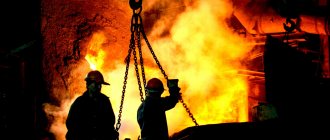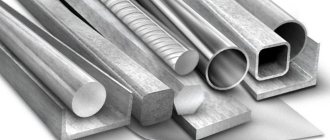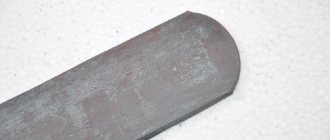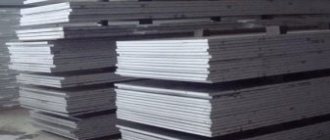The high popularity of such a material as stainless steel is explained by its unique characteristics that ordinary carbon steel alloys do not possess. Thanks to the wide variety of stainless steel grades available on the modern market, they can be selected to successfully solve various technological problems.
The appearance of stainless steel structures does not change throughout their entire service life
What do we know about stainless steel?
Corrosion-resistant steel or stainless steel is an alloy consisting of iron and carbon, additionally enriched with special elements that give it high resistance to negative environmental factors. The main one of these elements is chromium. Stainless steel contains at least 10.5% of it. Chromium, in addition to anti-corrosion properties, gives such alloys a number of positive characteristics:
- good processability by cold forming;
- exceptional strength;
- ability to obtain reliable connections by welding;
- possibility of long-term operation without loss of its characteristics;
- attractive appearance.
Chromium, contained in stainless steel in sufficiently large quantities, promotes the formation of a surface oxide film. It is this that protects the metal from corrosion.
Stainless steel sheet
Various grades (types) of stainless steel, and more than 250 of them have been created to date, contain in their chemical composition both chromium and a number of other alloying additives, the most common of which are nickel, titanium, molybdenum, niobium and cobalt. Naturally, steels with different proportions of alloying elements in their composition have different characteristics and areas of application.
As with any other type of alloy, carbon is an essential element in stainless steel. It is this element that gives the resulting metal alloy hardness and strength.
Today, it is impossible to imagine almost any industry without the use of stainless steel. Grades of this alloy, all of which are distinguished by the ability to successfully operate even in the most aggressive environments, are used for the production of cutlery and medical instruments, containers for food liquids and products, pipes for transporting aggressive media, household appliances, and much more.
Stainless steel rods
Types and brands
The first classification involves 3 divisions: heat-resistant, scale-resistant and corrosion-resistant. Heat-resistant high-alloy steels differ from heat-resistant steels, for example, in that products made from them can be used for some time at high thermal indices of the external environment and under load. Corrosion-resistant steels are often called stainless steels. And they are truly resistant to different types of corrosion: salt, acid, alkaline, chemical. This also includes intergranular corrosion, atmospheric and associated with electrical voltage.
Finally, scale-resistant steels are heat-resistant. They are used in an unloaded state or in a lightly loaded state. They are highly resistant to chemical deformation associated with the surface layer when the temperature of the external gaseous environment is above 550 degrees.
The classification also includes magnetic and non-magnetic alloys. The former are soft magnetic and hard magnetic. So the statement that stainless steel is a non-magnetic material is very controversial.
Concluding the list of characteristics, one cannot fail to mention the division of steels into the following types:
- mass – these are pipes, sheet and shaped products;
- bridge construction - used for cars and bridges;
- shipbuilding cold-resistant high strength - for welded structures that will operate at low temperatures;
- shipbuilding cold-resistant normal and increased strength - this is steel that resists destruction well;
- for steam and hot water – steel with an operating temperature of up to 600 degrees;
- low-low, high strength - a material used in aviation, but it is afraid of stress concentration.
It would be fair to note the importance of alloying components. They can be considered the basis, the main ingredient of the composition, which decides where the material will be used more effectively later.
Martensitic
The list of other types opens with martensitic grades, in which the amount of carbon is up to 0.7%, chromium is approximately 8-19%, and there is also some silicon and manganese. An example of such a brand is 30X13.
Ferritic
There is very little carbon in such steels - up to 0.15%, but there is much more chromium - up to 30% at maximum, and there will be a lot of silicon, manganese or titanium in the steel. An example of this type is 15Х25Т.
Austenitic
These are grades with a very low percentage of carbon, a moderate presence of chromium, varying concentrations of nickel (can reach up to 25%) and manganese (from 1 to 14%). There may be very little nitrogen and silicon there. An example of this class is 20Х25Н20С2.
Composite austenitic-martensitic
Carbon here ranges from 0.1 to 1%, there is quite a lot of chromium - on average 16%, there may be quite a bit of titanium, silicon and aluminum. Example - 08Х17Н6Т.
There are brands that are most suitable for making tableware. For example, 12X17. But in general, we can say that high-alloy steels are more than actively used in many industries, and the scope of their application is definitely only expanding.
What is included in stainless steel?
chemical composition of stainless steel
A few words about the “ingredients” used in the “cooking” of stainless steel. Or more precisely about alloying elements and their properties. By the way, steel is divided according to the degree of alloying. Austenitic corrosion-resistant steels are classified as high-alloy steels, since the total mass fraction of alloying elements is at least 10%, and the iron content is more than 45%. Let's continue the story about austenitic high-alloy chromium-nickel stainless steel 08Х18Н10, also known as AISI 304, which has alloying elements totaling approximately 28% (18% chromium and 10% nickel). This stainless steel is an alloy in which chromium (Cr) with nickel (Ni) and several other elements are added to iron (Fe) and carbon (C) during smelting. Carbon is responsible for hardness and strength, reducing toughness and ductility. A high carbon content will begin to reduce the cold brittleness threshold and can lead to difficulty welding the metal. Directly in imported stainless steel AISI 304, in contrast to its domestic counterpart, the percentage of carbon is much lower. Chromium in the alloy plays the role of the main “defender” in the fight against corrosion caused by exposure to aggressive environments and various temperatures. Since, thanks to chromium interacting with oxygen, a thin passive film of chromium (III) oxide Cr2O3 is formed due to the adsorption of oxygen occurring on the surface without destroying the crystal lattice of the original metal. This passive film, uniform in composition and evenly distributed over the entire surface of the metal, contributes to the appearance of stainless properties. Chromium, interacting with nickel, provides a stable austenitic structure, which contributes to high ductility, hardenability, good stampability and weldability of products. Nickel increases corrosion properties and prevents metal grain growth when heated. Chromium also increases the heat resistance of nickel, which, in turn, lowers the threshold of cold brittleness, which allows the use of stainless steel 08Х18Н10 in the temperature range from cryogenic -196 °C to high 800 °C. At temperatures above this value, metal oxidation occurs, accompanied by scaling and decarburization of the steel with complete volatilization of the protective passive film.
Speaking about the contact of AISI 304 stainless steel with food, I would like to note the influence of chromium and nickel. The combination of these two components in the alloy increases the corrosion properties and allows the use of products in aggressive environments. Although each product on store shelves has its own acidity levels, the acidic environment formed during the cooking process when interacting with stainless steel, even under the influence of temperatures during heat treatment of products, becomes insufficiently aggressive to affect or damage the integrity of the protective passive film layer , with which the steel is coated. And this, in turn, prevents the release of any harmful impurities from the metal that can interact with products. Therefore, steel can come into contact with food without any consequences.
Main characteristics of the metal
High-alloy steel has properties and characteristics that allow the products to be used more widely. Such steels have the following characteristics:
- Strength (achieved through heat treatment).
- Corrosion resistance.
- Resistance to deformation processes.
- Plasticity (compared to carbon steel, ductility is many times greater).
- Nonmagneticity (steels used in mechanical engineering).
- Elasticity.
- Hardening.
- Weldability.
Due to the fact that the alloy formula is different, the properties are varied. The structure is easily changed due to heat treatment and alloying components. In this way, it is possible to obtain the properties required by the project conditions. For example, high-alloy 18% chromium steel may contain nickel, which makes it possible to obtain corrosion resistance and cold brittleness.
Welding high-alloy steels allows us to obtain products that can be used in any climatic conditions. Thus, the stamp-welding method allows the final product to be used at critically low temperatures - down to minus 253 degrees Celsius. Special treatment with silicon makes it possible to obtain ferrosilides that can work in strong acids (nitric, phosphoric and others).
High-alloy steel is hard and highly abrasive. Thus, acid-resistant materials are C15 and C17, and chromium, vanadium and manganese increase the wear resistance of the alloy.
Physical properties of stainless steel
A patent for stainless steel was issued in 1913 in Great Britain. Its creator was metallurgist Harry Brearley. The invention gave a huge impetus to the development of steel and other industries.
Stainless steel gained its popularity due to its wide variety of physical properties, including anti-corrosion. New steels are made with the addition of various types of impurities to the main component. The physical properties of stainless steel depend on the type and volume of additives.
During long-term use, a number of grades of stainless steel can succumb to corrosion. This is influenced by the impurities of various metals included in its composition. However, such alloys also have a number of advantages, due to which the likelihood of oxidation is no longer so serious.
The main physical properties of stainless steel, which distinguish it from some other metals, are:
- Strength. This quality of steel allows us to produce products that compare favorably with analogues. Resistance to physical stress prevents the product from deforming, maintaining its original appearance for a long time. The reliability of high-quality stainless steel lasts up to 10 years.
- Resistance to aggressive environments. External conditions have virtually no effect on the material, which makes it possible to use it for a long time while maintaining all its properties.
- Heat resistance. All products made from this metal are highly resistant to temperature effects, including direct heating by fire. They do not change their size, shape, or properties in the event of large temperature changes.
- Environmental Safety. The anti-corrosion properties of the material prevent it from oxidizing. The metal does not contain components harmful to health, which makes it possible to use it in the food industry.
- Anti-corrosion properties. They are basic for stainless steel and prevent rust from appearing on the metal. Moreover, even alkalis and acids cannot affect the occurrence of corrosion.
- Appearance of products. It is very different from products made from other metals. The surface of the products continues to remain shiny and clean for a long time.
- Compliance. Processing stainless steel is quite simple. It is easy to make a product of the required shape from this metal.
Before choosing a metal with given physical properties, you should determine the purposes for which it is needed. Scientists have developed many different components and impurities that help make a metal with desired characteristics.
Properties and purpose of alloy steels
The presence of alloying elements and subsequent processing provide steel with a number of unique physical and chemical properties:
- Heat resistance
- Wear resistance
- Plastic
- Corrosion resistance
- Durability and many others.
Thanks to this, alloy steels are actively used to perform various technical tasks in almost all industrial fields: medical equipment and instruments, containers and equipment in the food industry, shafts, washers, gearboxes, components, structural elements in construction and mechanical engineering, etc.
Rating: 9.80/10 — 46 votes
Advantages of stainless steels
With the development of economic, scientific and technological progress, the requirements for the quality of materials used in areas of the national economy are growing.
Advantages of alloy metals:
- High level of anti-corrosion properties.
- Compliance with the standards stipulated by fire safety regulations.
- Reliability, long service life without changing technical characteristics.
- Ideal combination with any building materials.
- Variety of surfaces: polished, polished, matte, decorative.
- Wide selection of rolled metal products.
- Ease of processing, molding, and assembly of parts made from this type of steel.
- A wide range of brands with unique properties.
- Environmental safety, hygiene.
Why do you need to know the decoding of steel grades?
Anyone whose work is related to metals has had to deal with the concept of “steel grade”. Decoding the markings allows you to find out the chemical composition and physical properties of the alloy. Although at first glance the marking may seem quite complex, it is easy to understand. To do this, you need to understand the principle of its composition.
For such a brief description of the alloy, letters and numbers are used to indicate the chemical elements and their quantities. This means that for competent work with steels, it is important to know the abbreviations themselves and how each element changes the properties of the finished alloy. Then it will be possible to determine with utmost precision what technical characteristics a certain grade of steel has.
Having received an order for a product, designers develop a design and also select the most suitable steel grades for a particular case, based on decoding their properties. The device being created must function under certain conditions, so it is examined during movement - this is how it is possible to understand which parts will experience increased loads.
To establish requirements for the strength of elements, calculations are made. At the next stage, the metal is selected in accordance with steel grades according to GOST, which can withstand repeated loading and friction. The greater the load the product experiences, the more limited the designer is in choosing the material. Next, a prototype of the device is made from the selected metal and tested in accordance with the methods used in a particular area. At this stage, the steel grade can be changed. Let us note that most often steel is used for the manufacture of machines, devices and complex mechanisms.
Regardless of the specific area, working with metals requires an understanding of their grades, purposes and other characteristics displayed in the index. Thanks to the numbers and letters used in the code, it is possible to quickly understand the characteristics of the metal without requiring additional clarification. This article outlines the fundamental principle of classification, as well as a simple way to read the markings of the steels most common in production.
Nuances of welding corrosion-resistant steels
Corrosion-resistant steel has such qualities as heat resistance up to +650 °C and heat resistance within +480...+500 °C. Such alloys are characterized by low thermal conductivity, which is why structures made from them are often subject to distortion and warping. Whereas the oxidation of chromium leads to the formation of refractory slag, which interferes with welding.
To weld chromium stainless steels, mild thermal conditions are chosen, which implies low current density, direct current of reverse polarity, that is, the plus is attached to the electrode. It is also important to ensure a low cooling rate, in other words, it is important to avoid drafts during operation.
Corrosion-resistant steel is welded using electrodes with calcium fluoride coatings
.
Martensites and alloys belonging to the martensitic-ferritic class require hardening in the welding zone under normal conditions. You need to understand that there is a high probability of cracks appearing here, especially when it comes to thick-walled and rigid structures.
Recommended articles
- Types of metal corrosion: classification, methods of protection
- Protection of metal structures from corrosion and fire
- Metal hardening: technology and choice of temperature conditions
It is possible to improve the quality of welding by local heating to +200...+300 °C of products with a thickness of over 8–10 mm. However, the upper limit of heating and the time of holding this temperature are limited, since fragility or blue brittleness may appear. After welding, the joint area has increased hardness, therefore, after a certain time, the finished object is tempered to +700...+760 °C, due to which the restoration of resistance to intergranular corrosion is achieved.
When choosing corrosion-resistant steel, it is important to understand the further conditions of its operation, the load that the metal will experience, and additional properties of the product. If you have any doubts, it is recommended to seek professional advice.
Steel marking - the meaning of digital and letter indices
Knowing the designation of letter indices and the semantic meaning of the numbers used in steel marking, one can draw conclusions about the need for the proposed grade for a specific purpose, without even looking in the reference book. Overpay for the titanium contained in the alloy if you do not need the high fire-resistant properties acquired by alloying with this expensive metal.
Some letter indices can change the designating element, depending on its location in the marking. Consider the correspondence of letter indices:
- A (at the beginning of the marking) – S
- A (in the middle of the marking) – N
- B – Nb
- B – W
- G – Mn
- D – Cu
- E–Se
- K – Co
- M – Mo
- N – Ni
- P–P
- P–B
- C – Si
- T – Ti
- F – V
- X – Cr
- C – Zr
- Yu – Al
- h – REM
The amount of each of them in the alloy is determined by the numerical value following the letter indicating the element. Expressed as a percentage. In cases where an individual element is small, less than 1%, the number is not placed after the letter index. Carbon, as an important element, is located in front of the marking, but is expressed in hundredths of a percent.
FeNi and Ni alloys are marked only with letter indices. The exception is the number after nickel (mass fraction) and carbon (FeNi only).
If the steel was produced using special smelting methods or remelting methods, this is indicated with a hyphen after the marking. Such special methods and methods include various methods of vacuum remelting, electron beam melting, treatment with slags of synthetic origin, and others. The total number of specific methods for obtaining the required grade of alloy is specified in the standard: 24.
Let's look at examples of deciphering the markings of stainless steels 05Х12Н2М and 04Х14Т3Р1Ф-ВД. 05Х12Н2М contains 0.05% carbon, 12% chromium, 2% nickel, and up to 1% molybdenum content. 04Х14Т3Р1Ф-ВД stands for: carbon 0.04, 14% chromium, 3% titanium, 1% boron, vanadium less than 1% percent, obtained by vacuum arc remelting.
Alloy steel grades
Alloy steel grades vary. They are presented in a wide variety. Depending on the purpose of the steel, its marking is determined.
Today there are a large number of requirements for marking alloy steel. Numerical and alphabetic notations are used for this process. First, numbers are used for marking. They are indicators of how many hundredths of carbon are contained in a particular type of alloy steel. After the numbers there are letters, which indicate which alloying additives were used in the production of a particular type of alloy steel.
The letters may be followed by numbers indicating the amount of alloying substance in the steel material. If there is no digital designation after the designation of any alloying element, then it contains a minimum amount of it, not reaching even one percent.
Table 1. Comparison of steel grades of type Cm and Fe according to international standards ISO 630-80 and ISO 1052-82.
Steel grades
| St | Fe | St | Fe |
| One hundred | Fe310-0 | St4kp | Fe430-A |
| St1kp | St4ps | Fe430-B | |
| St1ps | St4sp | Fe430-C | |
| St1sp | — | — | Fe430-D |
| St2kp | St5ps | Fe510-B, Fe490 | |
| St2ps | St5Gps | Fe510-B, Fe490 | |
| St2sp | Sg5sp | Fe510-C, Fe490 | |
| StZkp | Fe360-A | ||
| StZps | Fe360-B | St6ps | Fe590 |
| StZGps | Fe360-B | Stbsp | Fe590 |
| StZsp | Fe360-C | Fe690 | |
| StZGsp | Fe360-C | — | |
| Fe360-D |
Table 2. Symbols of alloying elements in metals and alloys
| Element | Symbol | Designation of elements in grades of metals and alloys | Element | Symbol | Designation of elements in grades of metals and alloys | ||
| black | colored | black | colored | ||||
| Nitrogen | N | A | — | Neodymium | Nd | — | Nm |
| Aluminum | A1 | YU | A | Nickel | Ni | — | N |
| Barium | Va | — | Br | Niobium | Nb | B | Np |
| Beryllium | Be | L | Tin | Sn | — | ABOUT | |
| Bor | IN | R | — | Osmium | Os | — | OS |
| Vanadia | V | f | To you | Palladium | Pd | — | front |
| bismuth | Bi | In and | In and | Platinum | Pt | — | Pl |
| Tungsten | W | IN | — | Praseodymium | Pr | — | Etc |
| Gadolinium | Gd | — | Gn | Rhenium | Re | — | Re |
| Gallium | Ga | Gi | Gi | Rhodium | Rh | — | Rg |
| Hafnia | Hf | — | Gf | Mercury | Hg | — | R |
| Germanium | Ge | — | G | Ruthenium | Ru | — | Pv |
| Holmium | But | — | GOM | Samarium | Sm | — | Myself |
| Dysprosium | Dv | — | DIM | Lead | Pb | — | WITH |
| Europium | Eu | — | Ev | Selenium | Se | TO | ST |
| Iron | Fe | — | AND | Silver | Ag | — | Wed |
| Gold | Au | — | Evil | Scandium | Sc | — | From km |
| Indium | In | — | In | Antimony | Sb | — | Cv |
| Iridium | Ir | — | AND | Thallium | Tl | — | Tl |
| Ytterbium | Yb | — | ITN | Tantalum | Ta | — | TT |
| Yttrium | Y | — | THEM | Tellurium | Those | — | T |
| Cadmium | Cd | CD | CD | Terbium | Tb | — | Volume |
| Cobalt | Co | TO | TO | Titanium | Ti | T | TPD |
| Silicon | Si | WITH | Kr(K) | T\'liy | Tm | — | TUM |
| Lanthanum | La | — | La | Carbon | WITH | U | — |
| Lithium | Li | — | Le | Phosphorus | P | P | F |
| Lutetium | Lu | — | Leung | Chromium | Cr | X | X(Xp) |
| Magnesium | Mg | Sh | Mg | Cerium | Ce | — | Xie |
| Manganese | Mn | G | Mts(Mr) | Zinc | Zn | — | C |
| Copper | Cu | D | M | Zirconium | Zr | C | TsEV |
| Molybdenum | Mo | M | — | Erbium | Er | — | Erm |
AISI stainless steel marking
AISI marking is increasingly appearing not only on steel products from overseas, but also on Chinese, Russian, European and other products. This classification system takes its name from its birthplace, the American Iron and Steel Institute. The classifier was liked by consumers, manufacturers, and traders.
Classification
The grade of carbon and alloy steel is presented as a four-digit expression. The first digit in it indicates the main alloying component. The second digit identifies the secondary alloying element. The third from fourth digits indicate the carbon content.
- 1ZZZ–C
- 2ZZZ –Ni
- 3ZZZ –Cr+Ni
- 4ZZZ –Mo
- 5ZZZ–Cr
- 6ZZZ - Cr+V
- 7ZZZ –W
- 8ZZZ –Ni+Cr+Mo
- 9ZZZ –Si+Mn
The letter L at the end of the marking indicates reduced carbon content. The same letter in the middle of the marking indicates alloying of the alloy with lead to improve the mechanical properties of steel processed on machines. N at the end of the marking means nitrogen treatment to increase tensile strength, all other things being equal. The letter B in the middle of the marking is boron doping.
Modern industry identifies at least 150 brands by AISI. Let's look at the key, popular steel grades and where they are used.
300 series (family of chromium-nickel alloys)
- 301 - suitable for products with high ductility, characterized by rapid hardening under mechanical influence. Wear-resistant, increased fatigue strength
- 304 is the most widely used grade, which has found application in almost all industries
- 310 – heat-resistant, with the ability to work in aggressive environments at high temperatures (1000 degrees Celsius in oxidative, up to 10,000 in reducing). 310S is suitable for furnace elements in contact with high temperature gases and condensate
- 316 is a steel that holds second place after 304 in terms of application. A favorite brand for the production of equipment for food processing, for surgical instruments, units, modules operating in salt water. Resistance to pitting corrosion
- 321 - for the needs of chemists, the oil industry, welding equipment requiring use at temperatures up to 800 degrees
400 series (ferritic and martensitic steels)
- 405 Ferrite Matrix Welded Products
- 408-heat resistant
- 409 is the most affordable grade of stainless steel, used for car exhaust systems
- 416 - Easily processed on automatic machines due to the additional sulfur
- 420 - the main purpose of making cutlery, excellent polishing
- 430-ferritic matrix, can be processed by pressure, is resistant to corrosion, used in automotive finishing
- 440 - used for high-quality cutlery, a higher amount of carbon allows knives made from this steel to remain sharp longer, with proper heat treatment
Episode 500
- The 500 series contains chromite heat-resistant steel grades.
Episode 600
600 series - was originally created for patented steel grades that do not fall under classification. Today the subsection looks like this:
- 601-604 – martensitic low-alloy
- 610-613 – martensitic secondary hardening
- 614-619 – martensitic with chromium
- 630-635 – half-austenitic with compacted martensite. Used for pipes, pumps, valves. Corrosion resistance is close to 304
- 650-653 – austenitic steels operating under large temperature differences
- 660-665 – austenitic heat-resistant.
The information presented on this page will help you select the required grade of stainless steel in accordance with its characteristics and capabilities. Steel grades are classified according to two main classifiers GOST5632-2014, AISI. Examples explain the marking of stainless steels and alloys. The areas of application of key and popular brands in manufacturing industries are given.
Replacing pipe walls or sheet thickness
So, you decided to take the advice and order the goods individually. But, there is still a point. For example, you decide to order a stainless steel square pipe 25x25x2 mm, in the amount of 200 meters. The weight of a meter of such a pipe will be approximately 1.5 kg. Total weight 300 kg.
What will an unscrupulous seller do? Yes, it’s trivial, I’ll replace the 25x25x2 pipe with a stainless steel pipe 25x25x1.5 mm. Why? Because the weight of its meter is 1.14 kg, and the total weight is 228 kg. Let's assume that the cost of a kg of stainless pipe is 250 rubles, and we get a difference of 18,000 rubles. This is the difference in weight (72 kg) multiplied by the cost per kg. This is exactly how much you will overpay, with a total invoice amount of 75,000 rubles, this is about 24%. Thus, the “woeful supplier” is counting on your inattention and making money from it. The situation is exactly the same with stainless steel sheets.
- Remedy: Buy or borrow a caliper to measure wall thickness or sheet thickness.
Unpleasant surprise
In principle, the stories and situations described are quite standard, but there is one more trick. It is typical for inattentive buyers who, as they say, after “a fight, prefer not to shake the air.”
It looks like this, initially an invoice is issued, for example, in kilograms, for a certain number of meters or pieces, pipes, sheets or other goods. The price is high, but the weight is underestimated.
What happens next? Next, the goods are shipped, where the documents already indicate the real weight or even an inflated one. Accordingly, an additional amount “pops up” that needs to be paid. As a result, instead of saving money, you overpaid.
Remedy: Check your supplier invoices carefully. The more detailed the positions are described, the less likely there is to be manipulation. Before signing documents upon shipment, check the final quantity and cost of the goods.
Bottom line
Many sellers and buyers still do not understand the difference between business and fraud, between entrepreneurship and deception, between a “huckster” and a sales manager. In the end, everyone remains to their own. Someone even pays the bill to scammers who disappear and do not return the money.
- Therefore, it should be remembered that business is the principle of buying cheaper than selling. If it’s the other way around, then it’s bankruptcy; if you sold it but didn’t buy it, then it’s fraud. The rest is only your imagination and forethought.
Be healthy and attentive. Return to list
Classification
Based on their chemical composition, stainless steels are divided into:
There are austenitic stainless steels, which are prone to intergranular corrosion, and stabilized ones - with Ti and Nb additives. A significant reduction in the susceptibility of stainless steel to intergranular corrosion is achieved by reducing the carbon content (up to 0.03%).
Stainless steels that are prone to intergranular corrosion are usually subjected to heat treatment after welding.
Alloys of iron and nickel are widely used, in which, due to nickel, the austenitic structure of iron is stabilized, and the alloy turns into a weakly magnetic material.
Martensitic and martensitic-ferritic steels
Martensitic and martensitic-ferritic steels have good corrosion resistance in atmospheric conditions, in slightly aggressive environments (in weak solutions of salts, acids) and have high mechanical properties. They are mainly used for products subject to wear, as cutting tools, in particular knives, for elastic elements and structures in the food and chemical industries that are in contact with slightly aggressive environments. This type includes steel types 30Х13, 40Х13, etc.
Ferritic steels
These steels are used for the manufacture of products operating in oxidizing environments (for example, in nitric acid solutions), for household appliances, in the food industry, light industry and for heat exchange equipment in power engineering.
Ferritic chromium steels have high corrosion resistance in nitric acid, aqueous solutions of ammonia, ammonium nitrate, a mixture of nitric, phosphoric and hydrofluoric acids, as well as in other aggressive environments. This type includes steels of the 400 series.
Austenitic steels
The main advantage of austenitic steels is their high performance characteristics (strength, ductility, corrosion resistance in most working environments) and good manufacturability. Therefore, austenitic corrosion-resistant steels have found wide application as a structural material in various branches of mechanical engineering. Theoretically, products made from austenitic stainless steels are non-magnetic under normal conditions, but after cold deformation (any mechanical treatment) they can exhibit some magnetic properties (part of the austenite turns into ferrite).
Austenitic-ferritic and austenitic-martensitic steels
Austenitic-ferritic steels
The advantage of steels in this group is an increased yield strength compared to austenitic single-phase steels, a lack of tendency for grain growth while maintaining a two-phase structure, a lower content of highly deficient nickel and good weldability.
Austenitic-ferritic steels are widely used in various branches of modern technology, especially in chemical engineering, shipbuilding, and aviation. This type includes steel types 08Х22Н6Т, 08Х21Н6М2Т, 08Х18Г8Н2Т.
Austenitic-martensitic steels
The needs of modern technology for corrosion-resistant steels with increased strength and manufacturability have led to the development of martensitic (transitional) class steels. These are steel types 07Х16Н6, 09Х15Н9У, 08Х17Н5М3.
Iron-nickel and nickel-based alloys
In the manufacture of chemical equipment, especially for work in sulfuric and hydrochloric acids, it is necessary to use alloys with higher corrosion resistance than austenitic steels. For these purposes, alloys based on iron-nickel base type 04ХН40МДТУ and alloys based on nickel-molybdenum base N70MF, chromium-nickel base KHN58V and chromium-nickel-molybdenum base KHN65MV, KHN60MB are used.
Foreign grades of corrosion-resistant steels
Steel grades AISI 201 and AISI 202 belong to the austenitic group of alloys.
It is worth clarifying that the abbreviation stands for American Iron and Steel Institute or “American Institute of Steel and Alloys.” These metals contain chromium, nickel, manganese, copper, nitrogen, due to which high strength of the products is achieved. The material also lends itself well to deformation and easily changes shape.
The balanced composition of these corrosion-resistant steels allows them to stand out from the crowd with their high resistance to rust.
AISI 201 and AISI 202 are used for the production of household appliances, pipelines, and building structures.
The difference between these brands is the content of additional components. AISI 201 contains more carbon, sulfur, manganese and copper, which provides high strength and ductility. While AISI 202 contains more nickel. It should be noted that AISI 201 is an improved version of AISI 202, but both brands retain their physical characteristics even when products made from them are used in a moderately aggressive environment.
There are Russian analogues of these corrosion-resistant steels:
- AISI 201 can be replaced with 12X15G9ND;
- AISI 202 is close to 12X17G9AN4.
Steel grades of the 300 series are included in the chemical composition of the austenitic or duplex group of alloys. The type of stainless steel depends on the proportion of basic additives, such as carbon, nickel, chromium, titanium. It is important that this series is considered universal and popular in the market, as it has high strength, resistance to wear and rust.
Food grade stainless steel according to GOST
There is no official concept of food grade or technical stainless steel. This is the name given to any brand that is suitable for making cookware. Requirements for products intended for contact with products are set out in GOST 27002-86.
The list of possible alloys includes grades with an amount of carbon of at least 12%, chromium of at least 13%, possible presence of nickel in an amount of 5-13%, and molybdenum of about 2%.
Their selection is influenced by the following criteria:
- will the cookware be used for cooking?
- how long the contact is expected to last.
Also, there are no alloys that are used only for the manufacture of dishes, cutlery, etc. Dishes, pipes and tools can be made from the same grade. In this case, the final thermomechanical treatment can be applied in the same way.
Preferably, 12X13 stainless steel is used to make utensils that do not come into contact with food for a long time and are not subject to shock or heat.
Grade 12Х18Н10Т is a classic version of food-grade stainless steel, and since it is used in the mass production of not only tableware, its second name is medical steel.
Steel grades for food supplies
The classification of brands is carried out according to series, which indicate the internal structure after the final thermomechanical processing of the product.
There are 3 series that determine the properties of stainless steel:
Episode 400
— martensitic-ferritic stainless steel. They are distinguished by high manufacturability, i.e., good workability by pressure (rolling, stamping), and weldability. These grades contain 8-40% (on average 12%) carbon, and the main and only alloying element is chromium, contained in an amount of 13% (not less).
Stainless steel with a chromium content of 13-17% has a number of disadvantages: they are classified as weakly rusty, since with prolonged contact with water or mildly aggressive acids, pitting corrosion may appear on the surface.
This entire series cannot be used for products exposed to low temperatures (below -40 ºС) and shock loads.
Affordability and high machinability make these brands in demand for the manufacture of technical parts, structural elements, and pipelines. Cutlery (forks, spoons), coasters, dishes, and candlesticks are no exception.
| Russian classification | European equivalent |
| 08Х13 | AISI 409 |
| 12Х13 | AISI 410 |
| 20X13, 40X13 | AISI 420 |
12X17AISI 430 - used for the manufacture of dishes, cutlery, etc., limitedly used for contact with food and not intended for heat treatment.
Episode 300
— austenitic, austenitic-ferritic and austenitic-martensitic stainless steel. All grades in this series have increased corrosion resistance at temperatures up to 600 ºС (with the addition of alloying elements the temperature limit rises to 800-1100 ºС), and strength.
Nickel is added as the second alloying element in an amount of 5-13%, which contributes to obtaining an austenitic structure, and up to 2% molybdenum and/or 1% titanium are added to increase strength.
The series begins with a universal stainless steel, which is known in all spheres of human activity:
- 08Х18Н10 - chromium-nickel. The most commonly used steel is in the food industry.
Due to its complete inertness to water and mildly aggressive acids, it received the name “food grade”; if the carbon content in this alloy is increased to 12%, the name will sound like “medical steel”.
Intensively used in the chemical and medical industries.
- 10Х17Н13М2 - chromium-nickel-molybdenum alloy.
The additive of 2% molybdenum makes it durable and wear-resistant. It is also used for products in contact with food, but at high temperatures and pressure. These can be steam boilers, pipe systems for transporting liquid media. For industry, gas turbines are made from this alloy.
- 10Х17Н13М2Т - the previous alloy with the addition of titanium.
Titanium increases the operating temperature to 800-1100 ºС and the ability to work in aggressive environments with chlorine. Used in critical systems for the production of seamless pipes, as well as shut-off and connecting fittings for them.
| Russian classification | European equivalent |
| 10Х17Н13М2 | AISI 316 |
| 10Х17Н13М2T | AISI 316 T |
| 12-08Х1810Т | AISI 321 |
Episode 200
- with a predominance of only the austenite structure. Its properties are similar to both previous series, but the cost is much cheaper than the 300 series.
12X15G9ND - in this brand (it is the only one so far) nickel and molybdenum are replaced by two elements balanced in relation to each other: manganese and copper. High technology and low cost (relative to chromium-nickel brands) make this series stand out.
| Russian classification | European equivalent |
| 12X15G9ND | AISI 201 |
Alloying Additives Mission
High alloy steels contain:
- carbon;
- silicon (provides elasticity);
- manganese (provides hardness);
- titanium (promotes the removal of nitrogen and the formation of a dense structure, is responsible for heat resistance);
- molybdenum (affects heat resistance);
- vanadium (strengthens the structure);
- tungsten (prevents grain growth, strengthens the molecular lattice);
- cobalt (increases mechanical strength).
In steels of this group, the content of sulfur, aluminum, phosphorus, boron, niobium, and copper is permissible.
High-alloy special steels and alloys are classified according to their structure into:
- martensitic and austenitic-martensitic;
- ferritic and austenitic-ferritic;
- austenitic.
In terms of properties, consumers are interested in:
- heat resistant;
- heat resistant;
- stainless (corrosion resistant).
The table below provides information about well-known grades of high-alloy steels and describes the chemical composition.
Heat resistant stainless steel
The category of heat-resistant materials includes alloys that are capable of maintaining their structure and not changing their quality characteristics when exposed to temperatures above 550º C. The chemical composition and marking of this type is regulated by GOST 5632 - 2014. According to the production method, such stainless steel can be cast or deformable.
Metals vary in their ability to withstand certain loads at high temperatures. In accordance with these indicators, three types of stainless steel are distinguished.
- Heat resistant stainless steel. Does not corrode at 600°C.
- Heat resistant. Shows inertness to aggressive media at temperatures above 550°C.
- Heat resistant. Resists mechanical loads at 400 - 850°C.
In terms of composition, materials with increased heat resistance are:
- Martensitic. Brands produced using perlite additives. The mixture of metals is hardened at 950 - 1100 ºС. The resulting alloys contain more than 0.15% carbon, 11-17% chromium and small amounts of nickel, tungsten, molybdenum, and vanadium. They do not react with alkalis and acids. Prolonged exposure to a humid environment does not affect their technical characteristics.
- Austenitic. Steels have a homogeneous or heterogeneous structure. The homogeneous composition, which is not subjected to hardening, contains an increased amount of carbon and a maximum of alloying elements: Ni, Cr, Mn, Mo, V, Nb. Such alloys are resistant to temperatures up to 500°C. This class includes: 06Х14Н6Б, 08Х18Н12Т, 20Х23Н18, 07XI6H9M2. Heterogeneous grades undergo hardening and aging during the production process. This is necessary for the formation of carbide, carbide-nitride and intermetallic compounds. They strengthen the boundaries of the matrix and impart the necessary heat resistance to the alloy at temperatures from 700 to 750°C. Representatives of this type are steels: 08Х17Н13М2Т, 20Х25Н20С2, 45Х14Н14В2М.
- Nickel and cobalt. These are some of the best heat-resistant materials, capable of maintaining all technical parameters unchanged at temperatures up to 900°C. These grades are divided into homogeneous and heterogeneous alloys. These include: KHN77TYU, KHN55VMTFKYU, KHN70MVTYUB.
Stainless steel strength class A2, A4
For example, the designation on the head: A2-70, A4-70
| Group | steel grade | Diameters, mm | Strength class | Tensile strength, N/mm2 | Limit fluidity N/mm2 | Elongation at break, mm |
| Austenitic | A2, A4 | up to M39 incl. | 50 | 500 | 210 | 0.6d |
| Austenitic | A2, A4 | up to M24 incl. | 70 | 700 | 450 | 0.4d |
| Austenitic | A2, A4 | up to 24 incl. | 80 | 800 | 600 | 0.3d |
Application
The listed advantages contribute to maintaining a leading position in the rolled metal market. Anti-corrosion alloys are an indispensable material in heavy engineering, energy, oil and gas and agricultural sectors.
The material is in demand in the following areas of the national economy:
- Construction, architecture;
- production of equipment and medical instruments;
- pulp and paper production;
- food industry;
- transport engineering;
- chemical industry;
- electrical power and electronics;
- production of household appliances and household items.
The decorative qualities of stainless metals and the high level of anti-corrosion properties make it possible to use parts and elements made from them for facades, advertising installations, shop windows, and fountains. Railings, doors, stairs, and elevators are made from alloyed material.
Application of heat-resistant steels
Alloy metals, resistant to high thermal loads, are used for the production of pipes, parts, components of machines, units, and industrial equipment. This list includes:
- parts of thermal furnaces;
- parts of conveyor belts for furnace conveyors;
- heat treatment units;
- fuel combustion chambers;
- motors, gas turbines;
- methane conversion devices;
- furnace screens;
- exhaust systems; heating elements.
Heat-resistant stainless metal is the best material for the production of parts and mechanisms that will be used in aggressive environments at elevated temperatures.
Sources
- https://met-all.org/stal/marki-nerzhaveyushhej-stali.html
- https://generalsteel.ru/marki-nerzhaveyushchih-stalej/
- https://vt-metall.ru/articles/447-svojstva-nerzhaveyushhej-stali
- https://martensit.ru/stal/nerzhaveyushhaya-stal/
- https://tk-metal.ru/stal/marki-nerzhaveyushchei-stali-klassifikatsiya-rasshifrovka.html
- https://solidiron.ru/steel/marki-nerzhaveyushhejj-stali-i-ikh-kharakteristiki.html
- https://intehstroy-spb.ru/spravochnik/nerzhaveyuschaya-stal-marki-vidy-i-harakteristiki.html
- https://prompriem.ru/stal/pishhevaya-stal-marki.html


